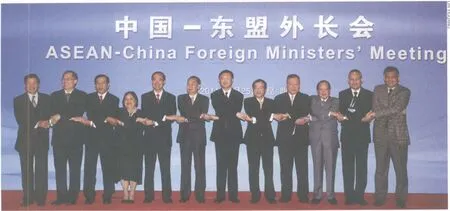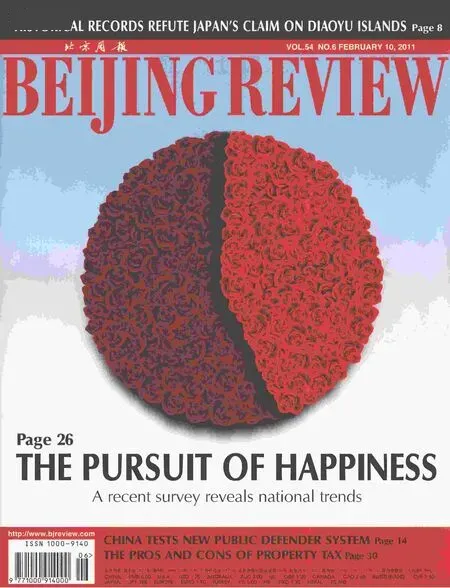Taking the Lead in Recovery
By DING YING
Taking the Lead in Recovery
By DING YING
China and its neighbors come together to build a global economic powerhouse

JOINING HANDS: Officials pose at the opening ceremony of the ASEAN-China Foreign Ministers’ Meeting in Kunming, capital of southwest China’s Yunnan Province, on January 25
In this post-financial crisis age, China has reason to take pride in Asia’s economic achievements. A huge developing nation with an emerging economy, it is the engine driving Asia’s astonishing growth.
China also has another reason to be proud, though. By conducting practical economic cooperation, it is promoting secure regional development. A peaceful and wealthy region, built through cooperation, will contribute to international economic growth, narrow the South-North gap, decrease global poverty, help establish new world economic and political orders and promote widespread peace.
Flourishing cooperation
Commenting on China’s relations with its neighbors, China’s Assistant Foreign Minister Hu Zhengyue said, in an interview with Xinhua News Agency in January, emerging economies like China, India and Indonesia had maintained robust economic growth and were helping to lead the world economy out of the shadow of the financial crisis.
To boost growth, China and other Asian nations are now in the process of creating free trade areas (FTAs). The China-ASEAN FTA, completed in 2010, is the world’s largest FTA among developing countries. It has created a healthy environment for trade and investment in the region, as it enables the factors of production—such as capital and technology, as well as natural and human resources—to flow more efficiently among countries, Hu said.
China is also working with other East Asian nations to push forward the establishment of an East Asia FTA, and to combat trade protectionism. It has signed an FTA agreement with Pakistan and has started bilateral FTA negotiations with South Korea.
The cooperation of China, Japan and South Korea not only serves their own interests, but also drives East Asian regional cooperation, Hu said. In 2010, leaders of the three nations mapped out a decade of future cooperation after two rounds of meetings in South Korea and Viet Nam. They agreed it was necessary to constantly improve their partnership and highlighted the strategic significance of trilateral cooperation.
Trilateral cooperation has continued to deepen in various fields, from logistics and technology to environmental protection, Hu said. The three nations also agreed in late December 2010 to establish a secretariat for their cooperation in South Korea this year. Moreover, they have set a goal to complete their joint FTA study—which involves the government, industry and academia—by 2012.
Hu said China and its Asian neighbors are also increasing financial cooperation. In 2010, China signed a currency exchange agreement valued at 150 billion yuan ($22.8 billion) with Singapore, bringing the value of its bilateral currency exchange agreements with Asian nations to 510 billion yuan ($77.5 billion).
Active economic cooperation generates cultural and social exchanges between China and its Asian neighbors, Hu said. For example, China conducted “friendly year”activities with India, Indonesia, Viet Nam and Myanmar in 2010, and the programs greatly enhanced their mutual understanding.
In the meantime, a record number of people traveled between China and other Asian countries in 2010. The personnel exchange between China and Northeast, Southeast and South Asian nations reached 25.42 million last year, increasing 17.2 percent from 2009.
New opportunities
For years, China has cooperated economically with its Asian neighbors, but now there are new opportunities before them, said Kang Shaobang, a professor with the Party School of the Central Committee of the Communist Party of China.
When it comes to trade, China and its neighbors complement each other perfectly, due to differences in economic development levels, industrial structures, natural resources and labor reserves, Kang said in a recent article inPeople’s Daily.
China exports labor-intensive products and low-value-added products to—and imports capital- and technology-intensive products from—economically developed nations, such as Japan, South Korea and Singapore. Meanwhile, it exports machinery, electric, chemical and textile products to neighboring developing nations, while importing agricultural and industrial raw materials and energy from them.
The complementary nature of China’s trade ties with neighboring countries will make regional trade progress possible, especially between China and large nations, like Russia, India and Indonesia, said Kang.
The changing global and regional economic patterns offer opportunities for further regional economic cooperation, said Kang. China and its Asian neighbors are active in multilateral cooperative mechanisms such as APEC, the G20, BRICS (Brazil, Russia, India, China and South Africa) and BASIC (Brazil, South Africa, India and China). These mechanisms have helped boost regional economic integration.
China and its neighbors will be more influential in the world economy in the aftermath of the global financial crisis, said Kang. This region, with the rapid economic development of China, Japan, India, ASEAN and Russia, has become one of the regions with the greatest economic potential in the world.
In 2008, this region accounted for 24 percent of world GDP, and was a global economic powerhouse, along with North America and Europe. When the global financial crisis seriously damaged the world economy in 2008 and 2009, Asia suffered, as well. But developing economies such as China, India and ASEAN quickly recovered, lifting themselves from the crisis with stunning economic growth. Estimates now indicate China and its neighboring economies will become the world’s largest regional economy—accounting for one third of world GDP—by 2020.
Along with the region’s rise, regional economic power will shift as well, due to countries’ varied development speeds, Kang said. Japan, the most developed country in the region, will become less influential, while emerging markets like China and India will play a bigger role.
From 1990 to 2009, Japan’s contribution to the regional GDP decreased from 61 percent to 32 percent, while that of developing economies increased from 39 percent to 68 percent. The numbers for China in that time spiked from 7 percent to 32 percent. In 2009, Russia accounted for 8.2 percent, India for 8 percent and ASEAN nations for 10 percent. South Korea made up 5.2 percent of the regional GDP, thanks to steady growth since its economic boom in the 1960s and 1970s.
A multifaceted economic structure has been established in China’s neighborhood, and cooperation and interdependence will continue to strengthen in the years to come, Kang said.
Asia’s economic and political patterns are undergoing major changes under the influence of world multi-polarization and economic globalization, said Hu. Generally speaking, peace, stability, cooperation and development remain the norm on this continent, he said, adding that Asia is becoming a vigorous and hopeful region. However, Asian countries now face urgent economic tasks, such as adjusting the economic structure and developing a green economy.
Asia also faces security challenges—both traditional and non-traditional—such as political turmoil in some countries, climate change, natural disasters and terrorism. In keeping with its mutually beneficial policies, China will continue to take part in regional cooperation, Hu said.
As long as Asian nations maintain communication and coordination based on mutual respect and stick to peace, development and cooperation, they will play an even more significant role on the world stage, he added.

